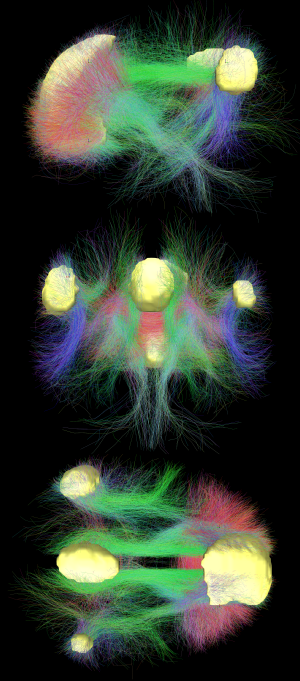“To see the world, things dangerous to come to, to see behind walls, draw closer, to find each other, and to feel. That is the purpose of life.” ~ James Thurber (The Secret Life of Walter Mitty)
Mind-wandering is a fascinating topic. I thought I’d start this category off with a peek behind the scenes of our grey matter whilst it’s engaged in day-dreaming and mental time travel; better known as memory. You might think our brains are static while you’re not concentrating on a specific task, but quite the opposite is true.
Scientists have produced evidence that for half the day our minds are wandering, (obviously not in one continuous epic day dream), and at night, whilst in REM sleep our minds wander into dreams. Despite the bad rap mind-wandering has received (even from a recent Harvard study), this can be no bad thing if we are designed to spend considerable chunks of time doing it.
In his brilliant book, The Wandering Mind, Michael Corballis, emeritus professor at the Department of Psychology at the University of Auckland, has defended our innate tendencies to drift into these surreal synapses and put forward a compelling case for mind-wandering in various contexts.
It’s taken me a while to get my brain in gear for this post. There have been so many opportunities to ponder and wander…
Walter Mitty
The daring, audacious day-dreaming of fictional character Walter Mitty is something to behold. His adventurous perambulations on the colourful landscape of his imagination have no equal. OK, some authors might argue with me on that one…
To alleviate his rather dull life, Walter indulges in frequent, exciting bouts of ‘zoning out’, but his life becomes infinitely more interesting when he embarks on a real-life adventure. In the Ben Stiller film version, his day-dreaming facilitates him stepping outside his comfort zone and undertaking the journey of his life.
Mind-wandering is the portal to our memory, imagination, creativity, originality, mental time travel, the minds of others and psychic phenomena.
In fact, evolutionary psychologists believe that our cerebral escapades were one of the earliest mental faculties to evolve in Homo Sapiens; our relatively modern branch of the Homo genus that emerged in the Pleistocene period some 200,000 years ago.
Wander/won’der/intransitive verb. To go astray, deviate from the right path or course, the subject of attention, etc.
The day-dreaming taboo
At school, if the lesson was boring I’d often find myself day-dreaming despite my best efforts to concentrate on the task in hand. I would never have let on that I was day dreaming of course, for fear of the teacher’s wrath.
I’ve often noticed my children drifting off into other worlds during homework, reading, watching television and chores, concocting all sorts of outcomes. Depending on the activity I gently try to get them back on track. Sometimes though, when appropriate, I participate with them in some community and family mind-wandering.
Ruby’s favourite mind-wandering realm is that of the animal kingdom. She can do the most brilliant animal sounds (honorary dolphin), and act like a monkey with the best of them!
I’ve been surprised on many occasions at their problem solving abilities on issues that matter to them, most assuredly bolstered by their focus free interludes!
I think I will be more tolerant of my childrens’ mind wanderings, especially when I’m giving them instructions or when they are getting ready for school.
It seems that the taboo of mind-wandering is slowly lifting. Of course, there is a time and a place for mind-wandering. It’s definitely not when you are operating dangerous machinery, flying a plane or driving a car, as Walter Mitty does in the opening scene of James Thurber’s book, The Secret Life of Walter Mitty.
In fact, you could be doing the exact same thing right now. As your eyes scan these words maybe your mind is roving elsewhere!
Mind-wandering can be as intrusive as it can be pleasant. Perhaps we’re having trouble switching off; we can’t get that particular song or ear-worm out of our heads, we worry about trying circumstances or future events while we are trying to rest.
Alternatively, our minds can experience some respite from long periods of focus and engaging tasks. Taking a brisk walk always clears my head. We may deliberately swing from a hammock on a beach in the Seychelles, recall a favourite holiday, meander through nature or imagine rather more intimate activities…
Let’s take a break from the heavy mental lifting now and listen to a selection of popular culture’s music on the subject.
Measuring Brain Activity
Our understanding of what the brain is doing when it’s zoning out is possible because of an accident. It was German physician Hans Berger’s fall from his horse into the path of a horse-drawn canon that precipitated his exploration of electrical activity in the brain.
Had his sister not sensed that he was in danger several kilometres away and contacted their father Hans may never have considered the possibility of telepathy and invented a technique we still use today, electroencephalography (EEG). When subjects were in a resting state with their eyes closed the EEG showed a fluctuation in voltage frequency ranging between 8 to 13 cycles, which was named ‘Berger’s Wave’. Today it is known as the ‘Alpha Wave’. Alpha brainwaves are perfect for day-dreaming and creativity!
Neuroscience has since sought to continue understanding how our brains work. Newer methods for measuring blood flow to the brain were invented to study what was termed by David H Ingvar as ‘undirected, spontaneous, conscious mentation’.
Positron Emission Tomography (PET) involves injecting radioactive substances into the blood stream to map activity in the brain, as well as functional magnetic resonance imaging (fMRI), which uses a powerful magnet to detect haemoglobin carried in the blood and thus map the brain’s network. In this way researchers can see which parts of the brain are active when a person is involved in a specific task compared to when they are idle.
The Default Mode Network
Surprisingly, the idling brain receives only 5 to 10% less blood than when engaged, and wider regions of the brain are active during idle moments. The brain regions active in the wandering mind have become known as the ‘Default Mode Network’.
The Default Mode Network covers substantial areas of the brain, mainly in the areas not used in perceiving the world or responding to it. This is the network that lights up when we embark on our mental meandering.
It seems that nature has equipped us with two equally important mental faculties: mind wandering and paying attention. How often we alternate between the two depends to a large extent on individual proclivities.
But it happens whether we like it or not and whether we realise it is happening or not.
The benefits of appropriate mind-wandering allow us to adapt to a complex world, especially when we need to escape the here and now, mull over past mistakes and consider possible futures and understand how other people’s minds work. Empathy would not exist without this ability. Neither would the creative spark of humanity and our innovations over millennia.
All our modern conveniences, possessions, clothes, cars, art, culture, buildings, technology and the like were once figments and flashes of inspiration in a zoned-out mind.
We are such stuff
As dreams are made on, and our little life
Is rounded with a sleep.
~ William Shakespeare (The Tempest)
A trip down memory lane
Our memory allows us to experience time as we know it, encompassing past, present and future, providing us with the ability to mentally time travel. We’ve all been there: trying frantically to remember someone’s name, retrace our steps to find lost keys, to recapture emotions and events that are meaningful to us and bury ones we’d rather forget. We use past events to help us envisage future events.
Memory is therefore a creative process. Memories are strengthened connections in the brain, all made possible by the Hippocampus (Major).
“She knew that she had a tendency to allow her mind to wander, but surely that’s what made the world interesting. One thought led to another, one memory triggered another. How dull it would be, she thought, not to be reminded of the interconnectedness of everything, how dull for the present not to evoke the past, for here not to imply there.” ~ Alexander McCall Smith, (The Novel Habits of Happiness)
The Hippocampus
This remarkable section of the human brain is what imbues us with a sense of where we are in space and time, and acts as a cognitive map.
It relates to personal matters, retrieval of personal events and making plans. Damage to this area can result in Anterograde Amnesia.
Because of its shape and resemblance to an equine sea creature, the name Hippocampus was derived from the Greek for seahorse. It’s located on the inner surface of the temporal lobes (behind the ears).
The Default Mode Network includes the prefrontal lobes, temporal lobes and parietal lobes, and activated areas overlap extensively. The Hippocampus is the hub of this network.
The hippocampus is so powerful that vividly imagined scenarios often appear to be real, and the line between fiction and reality becomes blurred. Sometimes these ‘scenes’ can be remembered as though they actually happened. This is how false memories occur.
It may seem the stuff of futuristic, nefarious thrillers (cue book idea), but it’s possible to put memories into people’s heads that weren’t there.
Now, what was I saying? Are you still with me?
Perhaps this is good place to rest and mind-wander for a bit. Next time I’ll explore the role of language, storytelling and psychical phenomena in our mind-wandering excursions.
In the meantime I’ll leave you with the exquisite reveries of Claude Debussy:
Thought is the labour of the intellect, reverie is its pleasure. ~ Victor Hugo









Pingback: Surreal Synapses: Stories – The Miracle of the Creative Mind | rhap.so.dy in words
Pingback: 4 Fascinating Neurological Processes to Help Fulfill Dreams | rhap.so.dy in words